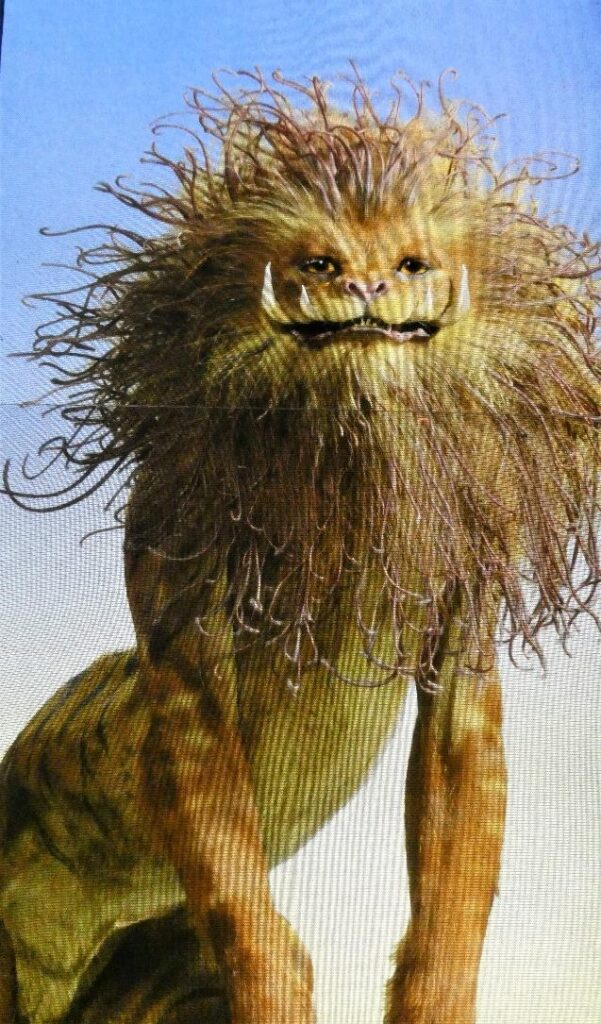An Ancient Chinese Bestiary in “Fantastic Beasts: The Secrets of Dumbledore”: Fantastic Bestiaries and Where to Find Them – Part 2
by Dr. Beatrice Groves
In the movie [Fantastic Beasts: The Crimes of Grindelwald] I include a Chinese creature. I’ve been immersed in a bestiary from China – mythical creatures and so on with their various properties. So, I can’t say too much now, but I’m using something from China in the next movie as well. So, at the moment my head is full of Chinese mythical creatures…I don’t want to say too much because I know what’s going to happen in the next story, but I think that there are other interesting places that Chinese mythology can lead us.

J.K. Rowling revealed in November 2018 that Chinese beasts would be central to Fantastic Beasts: The Secrets of Dumbledore. We know the Chinese bestiary she is referring to here because it has, at certain times over the last few years, been visible on her webpage – it is the Shan Hai Jing or, in the English translation Rowling has been reading: A Chinese bestiary: strange creatures from the guideways through mountains and seas (translated by Richard E. Strassberg, 2002). Prior to the release of Crimes of Grindelwald, Rowling said that “in Chinese mythology, there’s a Chinese bestiary that is utterly fascinating. The Zouwu is terrifying – if you’re a normal human being – and to Newt Scamander – like a big kitten. This is how it is described in Chinese mythology: gigantic, elephant-sized cat, five-colored.”

Back in 2018, therefore, I began reading through the Shan Hai Jing and, to be frank, after reading through over two hundred gnomic descriptions of strange beasts, I was beginning to lose heart that I would ever find the zouwu. It finally turned up as beast number two hundred and eighty-nine – hurrah! – so, I can confirm that Rowling’s reading was indeed no cursory flick-through. This is the description from Richard E. Strassberg’s translation (the version Rowling has been studying):
ZOUWU In the Land of the Lin Clan is a rare beast as large as a tiger, five-colored, and with a tail longer than its body. It is called the Zouwu. When riding it, one can cover one thousand li in a single day.
Rowling did not mention in the interview three of the other aspects of the zouwu mentioned here – that its tail is longer than its body, that it can be ridden, and that it can cover vast distances in a single day – but she uses them all. Strassberg’s notes add some further information:
Rare creatures similar to the Zouwu obtained from the Lin Clan are mentioned in several other early texts, though with variant names and appearances. Guo Pu noted a myth in the Six Bow-Bags that is virtually identical to the one about Lucky-Measure. In this case, it is the Zouwu that is obtained from the Land of the Lin Clan and presented to King Zhou of the Shang as a ransom for Bochang, the future King Wen of the Zhou.
The idea of the zouwu being used as a ransom for a future king has an immediate storybook appeal (although we know Newt would not use the zouwu for such a purpose), but nonetheless, the repatriation of the zouwu makes sense as an ostensible reason for Newt to travel to China in Secrets of Dumbledore – just as he traveled to America in the first movie apparently to return Frank the thunderbird to his home.

Rowling describes the Shan Hai Jing as “utterly fascinating,” and it is not difficult to see why. It has a number of truly fantastic – in both senses of the word – beasts. These include the fabulously named thoroughly-odd, which “resembles a tiger with wings.” There are also pearl-turtles (which are “a lung with eyes and six feet” that spits out pearls), bang-fish (“which have the basic form of a turtle and make a sound like a goat”), the changfu (“whose form resembles a chicken with three heads, six eyes, six feet, and three wings… Eating it will prevent sleep”), and the five-colored shade-bird, which can blot out the sun, overshadowing entire towns, as it flies.
The most beautiful creatures in this bestiary are the two-headed honghong-rainbows – about which Strassberg notes:
Rainbows were thought to lack feet and tails. Their two heads may symbolize the conjunction of yin and yang energies, hence, they also functioned as poetic images of love. When appearing over households, rainbows were generally believed to be auspicious… In some myths, they were associated with divine women. Rainbows were classified into many varieties, and Yuan Ke suggested that the Honghong were specifically evening rainbows.
I doubt we’ll see this astoundingly lovely “beast,” – but I did think of it when we saw the rainbow wings of the new bird that carries Newt. This wyvern accords with the Muggle version of the beast in some respects (it is dragon-like and has two legs, just as the wyvern does in British heraldry) but it is otherwise an entirely new beast. One of these new aspects appears to be its rounded bill (possibly inspired by the spoonbill Rowling used as a Twitter header in 2016). Another is its rainbow wings – and if these recall the beautiful rainbow symbolism of the Shan Hai Jing then the wyvern’s appearance will be auspicious for Newt.
One of the main sources for Rowling’s knowledge of Chinese beasts, however, prior to her more recent reading of this ancient bestiary, may have come from Jorge Luis Borges’s The Book of Imaginary Beings (1957). There are other reasons to suspect this book is a source for Harry Potter, but suffice it to say here that the Borges’s bestiary shows extensive overlap with the magical animals of the Wizarding World – it details mandrakes, unicorns, the phoenix, centaurs, Cerberus, chimera, sirens, the kraken, and the sphinx (all influential on Harry Potter) and the manticore, naga, salamander, and mooncalves (all appearing in Fantastic Beasts). Borges quotes, for example, a beautiful interpretation of Cerberus (the classical three-headed dog of whom Fluffy is a modern incarnation), which may have influenced Rowling in choosing Fluffy as the first obstacle in her hero’s first quest:
This Dog with three Heads denotes the past, the present, and the Time to come; which receive, and, as it were, devour all things. Hercules got the better of him, which shews that heroic Actions are always victorious over Time, because they are present in the Memory of Posterity.
Particularly relevant for Secrets of Dumbledore, however, is the extensive attention that Borges pays to classical Chinese beasts. My final post tomorrow will be about the qilin and the phoenix – which look set to be the most important mythological beasts in the upcoming film. I will leave you, therefore, with what Borges writes about the qilin, an animal he calls “The Unicorn of China.”
The Chinese Unicorn, the k’i-lin, is one of the four animals of good omen; the others are the dragon, the phoenix and the tortoise. The Unicorn is the foremost of all the 360 creatures that live on land. It has the body of a deer, the tail of an ox, and the hooves of a horse. Its short horn, which grows out of its forehead, is made of flesh; its coat, on its back, is of five mixed colors, while its belly is brown or yellow. It is so gentle that when it walks it is careful not to tread on the tiniest living creature and will not even eat live grass but only what is dead. Its appearance foretells the birth of an upright ruler. To wound the Chinese Unicorn or to come across its dead body is unlucky. The span of this animal’s natural life is a thousand years.
When Confucius’ mother bore him in her womb, the spirits of the five planets brought her an animal “having the shape of a cow, scales of a dragon, and a horn on its forehead.” This is the way Soothill reports the annunciation; a variant of this given by Wilhelm tells that the animal appeared on its own and spat out a jade tablet on which these words were read:
Son of mountain crystal [or of the essence of water] when the dynasty crumbles, thou shalt rule as a throneless king.
Seventy years later, some hunters killed a k’i-lin that still had a bit of ribbon around its horn that Confucius’ mother had tied there. Confucius went to look at the unicorn and wept because he felt what the death of this innocent and mysterious animal foretold and because in that ribbon lay his past.
In the 13th century, a scouting expedition of Emperor Genghis Khan, who had undertaken the invasion of India, met a creature in the desert “like a deer, with a head like that of a horse, one horn on its forehead, and green hair on its body,” which addressed them, saying, “It is time for your master to return to his own land.” One of Genghis’ Chinese ministers, upon consultation, explained to him that the animal was a chio-tuan, a variety of the k’i-lin. “For four years, the great army has been warring in western regions,” he said. “Heaven, which has a horror of bloodshed, gives warning through the Chio-tuan. Spare the Empire for Heaven’s sake; moderation will give boundless pleasure.” The Emperor desisted in his war plans.
Twenty-two centuries before the Christian era, one of the judges of Emperor Shun was in possession of a “one-horned goat” which refused to attack the wrongly accused but would butt the guilty.
Margoulies’ Anthologie raisonnée de la littérature chinoise (1948) includes this mysterious, soft-spoken allegory, the work of a ninth-century writer of prose:
It is universally held that the unicorn is a supernatural being and of auspicious omen; so say the odes, the annals, the biographies of worthies, and other texts whose authority is unimpeachable. Even village women and children know the unicorn is a lucky sign. But this animal does not figure among the barnyard animals, it is not always easy to come across, it does not lend itself to zoological classification. Nor is it like the horse or bull, the wolf or deer. In such circumstances we may be face to face with a unicorn and not know for sure that we are. We know that a certain animal with a mane is a horse and that a certain animal with horns is a bull. We do not know what the unicorn looks like.
Dr. Beatrice Groves teaches Renaissance English at Trinity College, Oxford, and is the author of Literary Allusion in Harry Potter, which is available now. Don’t miss her earlier posts for MuggleNet – such as “Solve et Coagula: Part 1 – Rowling’s Alchemical Tattoo” – all of which can be found at Bathilda’s Notebook. She is also a regular contributor to the MuggleNet podcast Potterversity.


